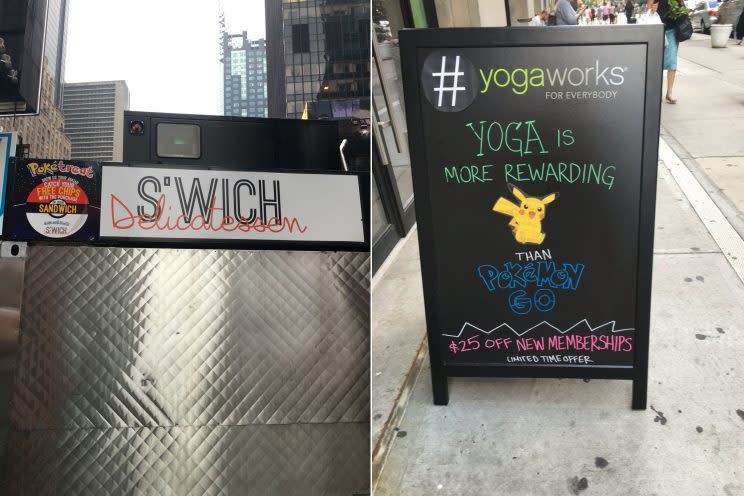How Pokémon Go could have a big impact on Yelp
The augmented-reality mobile game Pokémon GO, out less than a month, has already been downloaded an estimated 75 million times. That’s more than the red-hot dating app Tinder, and it’s approaching the 150 million daily active users of Snapchat.
More than three weeks after its release, it is still No. 2 in the iOS App Store. It’s the most viral mobile game of all time, and it has business implications not just for Nintendo, which owns one-third of The Pokémon Company and invested in developer Niantic, but for other, more established tech companies—like Yelp.
Yelp has been around since 2004, and went public (YELP) in 2012. It was the early leader in user-generated restaurant reviews, but has faced increased competition in recent years from Google (which owns Zagat), TripAdvisor, and others. And now, strangely, Pokémon Go could cause Yelp some trouble, too—or it could give the app a boost. Yelp is hoping the latter.
Earlier this month, Yelp added a filter to its mobile app to show which restaurants have PokéStops nearby. (PokéStops, within the game, are designated buildings or sites that can yield extra pokéballs or other goodies when visited.) Think about the significance of this: a 10-day old mobile game so fervently captured attention that it earned its own designated tool on an eight-year-old mobile app. It is a reminder of the power of this game franchise.
Separately, many restaurants are spending money within the Pokemon GO app to purchase “lures” (hot spots that attract pokémon within the game) to boost business. Outside, on their windows or with signs, they are advertising discounts to Pokémon GO players. McDonald’s Japan became the first business to partner with Pokémon GO as an official advertiser. And all of this could be bad for Yelp.

If gamers begin choosing where they will eat lunch or dinner (or where they shop) based on proximity of pokémon, they might stop using the Yelp app for those services. (Restaurants and shopping are the two biggest categories of review on Yelp, both with around 20% of all Yelp reviews.) Yelp is obviously attempting to combat this, but if the top priority becomes catching pokémon, and not reading food reviews, users might just go to their closest pokémon-infested area and eat at whatever is nearby, Yelp stars be damned. Yelp did not respond to requests for comment for this story.
But some analysts believe the viral mobile game is a rising tide for all tech boats. “I see it more as an opportunity than a threat,” says Tom Forte, consumer Internet analyst at Maxim Group. “This is an opportunity for Yelp to showcase that Yelp has the best local user-generated content.” That is: If anyone does start choosing restaurants solely to find pokémon, they’ll quickly miss the reliable reviews (though many question how reliable) on Yelp. “It’s an example of how augmented reality can be used to drive commerce.”
Interestingly, there are other recent, much quieter examples of companies trying out augmented reality, and one of them was… Yelp. Back in 2009, Yelp added a tool called “Monocle” to its mobile app. Yelp launched it so quietly that one site calls it “an Easter Egg feature.” When you tap Monocle and pan your phone’s camera around in front of you, restaurant descriptions pop up, even for places that are many blocks away. Though it is less sexy than cute critters you can catch, it is the same basic use of augmented reality.
Another company to employ augmented reality more recently is Wayfair, the online-only furniture retailer that went public (W) in 2014. Last month, using Google’s augmented reality platform Tango, Wayfair launched a separate app called WayfairView. It allows shoppers to select an item on the Wayfair website, then hold their phone up and see exactly how the item will look in their home. It is augmented reality, applied to a very utilitarian function: Will that couch fit there?
And finally, the posh British retailer Burberry has a feature that, while not AR, is sort of a close cousin. In 2013, Burberry added “smart personalization” in some of its flagship stores using RFID chips. It’s more of a marketing tool than anything: Large, interactive screens around the shop can display messages specific to you. Forte, who covers Burberry, likens it to a famous scene in the movie “Minority Report,” where Tom Cruise’s character, who has had his eyes replaced with a stranger’s, walks into a Gap store and a screen scans his retina and says, “”Hello, Mr. Yakamoto, welcome back to The Gap! How did those assorted tank tops work out for you?”
In Burberry stores with the RFID technology, Forte says, “The screen will say something like, ‘This suit was made for Tom Forte.’ It gives you an opportunity to connect with the brand.” Nike plans something similar with its new Nike+ app, launching later this summer.
Augmented reality is coming to the fore thanks to Pokémon GO, and it is having an impact on many different businesses. But it’s still in its infancy. “It’s bringing the online world offline,” Forte says. “And it is becoming… not mainstream, because it really isn’t there yet, but it’s getting closer to becoming mainstream.”
In a July 19 note, Citi downgraded Yelp stock from “buy” to neutral, but didn’t mention Pokémon GO. The stock is up 5% in the last month; Nintendo stock is up 45%.
—
Daniel Roberts is a writer at Yahoo Finance, covering sports business and technology. Follow him on Twitter at @readDanwrite.
Read more:
Pokémon GO is much bigger than Nintendo
Amazon beats in Q2 again, thanks to cloud services
Facebook reports another mega quarter, crushing earnings
How much longer can Netflix remain the streaming-content king?

 Yahoo Finance
Yahoo Finance 